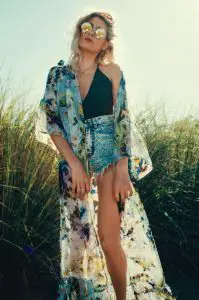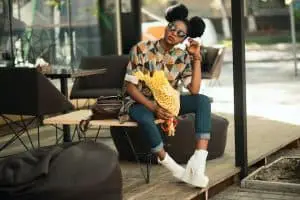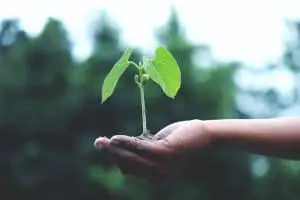Introduction
As we’ve discussed in previous posts, sustainability in fashion is pursued by designers and managers alike by focusing on the extended lifecycle of a garment. This, however, can be a daunting task, as any small change to design, manufacturing or distribution can become extremely costly and severely impact the bottom line.
Moreover, there are so many possible ‘sustainability’ initiatives available that the process of opting for one or the other makes it hard for a designer to identify at what stages to act, and in what ways change the production process.
This is why a handy tool was created to understand the workflow of sustainability better.
The Ecodesign Strategy Wheel breaks down the process of production of a fashion item and makes a series of suggestions related to what can be done at each stage of production to lighten a fashion firm’s carbon footprint. The ecodesign strategy wheel comprises seven steps: design innovation, material sourcing, processing and manufacturing, distribution, use, optimised use, optimised end of life.
In this post, we are going to focus on the first link of the sustainability chain: design innovation.
- Innovation in the Eco-Sustainable Strategy Wheel
- Sustainability through product innovation
- Sustainability through business model innovation
- Conclusions
1. Innovation in the Eco-Sustainable Strategy Wheel
- The Ecodesign Strategy Wheel starts with innovation, as it’s with innovative thinking that many environmentally-conscious practices can be established. Innovation in fashion is defined as the process of integrating new technologies and design ideas into the research and development stage of a firm’s value chain.
Innovation can come in two formats, either by focusing on the product and creating more sustainable ways of producing it (for instance using recycledrecyclable materials) or by focusing on creating a new business model. As we’ll see in the next paragraphs an example of an innovative approach to business modelling is provided by share economies. Let’s look at each possibility individually.
According to the Eco-sustainable strategy wheel, examples of innovative strategies can entail for initiatives consisting in:
- Rethinking about ways in which new value can be created in the fashion industry
- Enabling sharing as much as ownership of a product
- Future-proof your products to stand the test of time
- Design to mimic nature, using live organisms in a product.
2. Sustainability through product innovation
Product innovation relates to how a product is designed. There are many different approaches or schools of thought when it comes to innovation in design. For the sake of clarity we can list six different forms of design innovation strategy:
Multifunctionality. Designing clothing that can be worn in a variety of situations, because of the way garments are designed. These products allow different uses in different circumstances, such as adaptation to diverse social situations, weather conditions, etc. Multifunctionality allows users to ‘consume less’ as one garment can be used for a variety of situations instead of creating the need to buy a variety of different items for similar purposes. Multifunctionality also increases a garment’s durability.
Trans-seasonal. One of the most impactful aspects of fashion pollution derives from the high-paced cycle of production. Fast fashion companies are now putting new items on the store’s shelves every six-weeks. Instead of having two seasons (FallWinter and SpringSummer), fast-fashion retailers have created a production cycle which creates an average of 8 seasons per year. As we’ve discussed in several other posts, true fashion sustainability should aim at influencing consumer behaviour. Brands that create trans-seasonal designs allow customers to ‘escape’ the weatherseason logic and overall consume less.
Modular Design. According to this approach, designers are able to create garments that allow users to deconstruct and reconstruct their clothing, using the same item in a variety of configurations. This type of modular design can become a competitive advantage when developing collections for children who may need to change clothing size often.
Slow Fashion. Slow Fashion is an awareness and an approach to fashion, which considers the processes and resources required to make clothing focusing on sustainability. Slow Fashion involves buying better-quality garments that will last for longer. Firms that follow this philosophy value fair treatment of people, animals and the planet. Italy’s country of origin effect ‘Made in Italy’ is a label used to express how Italian brands strive to represent the high-quality segment of slow fashion. We discuss COO more in detail in this post.
Biomimicry. Biomimicry can be defined as an emulation of nature as a source of design inspiration. There are many examples of nature-inspired design, one of the most popular is velcro, which is a fabric capable of inducing entanglement, and was inspired by how bees are able to transport pollen by entangling it on their skin.
As we discuss in many of our posts in fashion, innovation can come both from the creative teams and from the business teams within a firm. In the next section of this post we’ll address business modelling for sustainability in greater detail.
3. Sustainability through business model innovation
Let us, for instance, make an example of a problem that is addressed by a variety of fashion customers: accessing high-end fashion without paying premium or luxury pricing. In this case, in fact, there are two possible approaches to solving this problem: either by designing a product or by designing a business model.
Fast fashion retailers are an example of companies which pursue the first approach. By following the “trickle-down” approach fast fashion companies bring down to a wider audience of customers haute couture fashion items and use vertically-integrated supply chains to deliver a product which is very similar to luxury item but is sold at a much lower price. This approach leverages both manufacturing expertise and strategic branding (claiming to sell ‘the same for less’).
This approach, however, is innovative but it’s not sustainable. Vertical retailers pursue a very fast fashion cycle, which is very environmentally problematic as it fosters a culture of “use-and-throw-away“.
Examples of companies who have instead been both innovative and sustainable are those which partake into the world of sharing economies. More and more firms are challenging the traditional concept of ownership as they are providing a different perspective on how to solve this problem: not by owning something that costs less, but by renting instead of owning.
Le Tote is an example of these typologies of companies. Le Tote allows its customers to choose from a variety of looks, allows users to rent clothing for a monthly fee and optionally allows the purchase of those items that a customer loves.
4. Conclusions
All in all, innovation needs to meet behavior, meaning that companies who want to be sustainable need to challenge the most fundamental assumptions regarding fashion consumption in order to create something new to bring to the market. Decisions toward sustainability made at the design stage, are capable of making the most significant impact on a product’s sustainability, and in this sense, firms need to address environmental challenges from the first stroke of the pencil.







